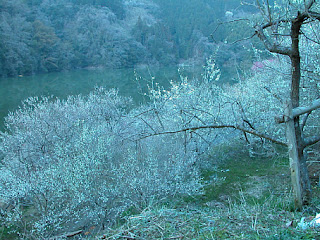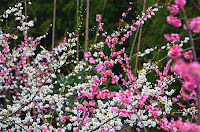 |
| Tsukigase Bairin on March 24, 2008 photo by 高画質壁紙写真集無料壁紙 |
Tsukigase Bairin(月ヶ瀬梅林, Tsukigase ume grove) in Nara City, Nara Prefecture has a long history.
Smoke-dried, young ume fruits were used as an ingredient for safflower dyes. Tsukigase was a major production area of ume fruits for safflower dyes. It is said that there were 100,000 ume trees in the area around 1810 to 1830.
 |
| Tsukigase Bairin on March 24, 2008 photo by 高画質壁紙写真集無料壁紙 |
The oldest ume tree in the grove is estimated to have lived 600 years, so it is believed that the origin of the grove goes back at least 600 years.
 |
| Tsukigase Bairin on March 24, 2008 photo by 高画質壁紙写真集無料壁紙 |
The Tsukigase Bairin was first introduced as a site of scenic beauty in a book published in 1772.
 |
| Tsukigase Bairin on March 24, 2008 photo by 高画質壁紙写真集無料壁紙 |
The production of ume fruits decreased with the decline of safflower dyes after the Meiji period. The ume grove came to ruin, but it was designated as a national scenic beauty in 1922 due to the efforts by local people and government to preserve the grove.
 |
| Tsukigase Bairin photo by 高画質壁紙写真集無料壁紙 |
However, the grove were almost forced to be converted into fields during the war. A dam's construction threatened to submerge about 3,800 ume trees after the war. Some transplantable old trees were moved to some areas near Tsukigase Bairin, and a new ume grove was made in Tsukigase Village.
Now about 13,000 ume blossoms attract many tourists.
 |
| Hirohashi Bairin on April 3, 2006 photo by 高画質壁紙写真集無料壁紙 |
Hirohashi Bairin(広橋梅林) is one of the the three major ume groves in Nara Prefecture, along with Tsukigase Bairin and Ano Bairin(賀名生梅林).
 |
| Hirohashi Bairin photo by 高画質壁紙写真集無料壁紙 |
 |
| Hirohashi Bairin photo by 高画質壁紙写真集無料壁紙 |
 |
| Minabe Bairin on February 28, 2005 photo by 高画質壁紙写真集無料壁紙 |
Minabe Bairin(南部梅林, Minabe ume grove) in Wakayama Prefecture has 20,000 ume trees on its 30-hectare site.
Minabe Town and Tanabe City in Wakayama Prefecture are major production areas of ume fruits for umeboshi(pickled ume fruits.)
A species of ume called Nanko-ume(南高梅) is considered to be the finest product for umeboshi. It was originated in Minabe Town.
 |
| Yoshino Baigo on March 14, 2010 photo by 高画質壁紙写真集無料壁紙 |
The Yoshino Baigo Ume Festival(吉野梅郷梅まつり) being held at Yoshino Baigo(吉野梅郷) in Ome City, Tokyo from February 18th to March 31st.
 |
| Yoshino Baigo on March 14, 2010 photo by 高画質壁紙写真集無料壁紙 |
 |
| The World's Ume Park on March 17, 2006 photo by 高画質壁紙写真集無料壁紙 |
The World's Ume Park(世界の梅公園) in Hyogo Prefecutre has various kinds of ume trees that come from East Asia including China, Taiwan, Korea and Japan.
 |
| The World's Ume Park on March 17, 2006 photo by 高画質壁紙写真集無料壁紙 |
 |
| The World's Ume Park on March 17, 2006 photo by 高画質壁紙写真集無料壁紙 |
 |
| Ono-baien photo by 高画質壁紙写真集無料壁紙 |
Ono-baien(小野梅園, Ono ume garden) in Zuishin-in Temple(隨心院), Kyoto
 |
| Ono-baien photo by 高画質壁紙写真集無料壁紙 |
 |
| Osaka-jo Castle Park on March 21, 2008 photo by 高画質壁紙写真集無料壁紙 |
Osaka-jo Castle Park(大阪城公園) in Osaka opened in 1974. As of March 2006, the park had 1,240 ume trees of 97 different kinds on its 1.7-hectare site. Admission to the park is free.
 |
| Osaka-jo Castle Park on March 21, 2008 photo by 高画質壁紙写真集無料壁紙 |
 |
| Kyoto Imperial Garden photo by KYOTOdesign |
Kyoto Imperial Garden(京都御苑) has about 220 ume trees.
other major ume-blossom viewing spots in the Kanto region:
●Ogose bairin (越生梅林) in Ogose Town, Saitama Prefecture is one of the three major ume groves in the Kanto region.
●The origin of Soga Bairin(曽我梅林) in Odawara City, Kanagawa Prefecture dates back about 600 years. some people say it started when many ume trees were planted to store ume fruits for umeboshi as a military ration.
●Atami Baien(熱海梅園, Atami Ume Garden) in Kanagawa Prefecture opened in 1886. As of January 2009, The garden had 454 ume trees of 60 different kinds including 100-year-old trees.
Thank you for these gorgeous photos, what a great present for the weekend, Ichinen!! It looks like pastelpaintings of the gardens of the painter Monet. In the past I used often to paint pastelpaintings. The blossoms are in so much colors, oh I wish I could ever go to Japan!!
ReplyDeleteThank you and have a nice weekend, Ilona
Most ume blossoms have yet to bloom...
DeleteUme blossoms are more subdued than cherry ones but have a fine fragrance.